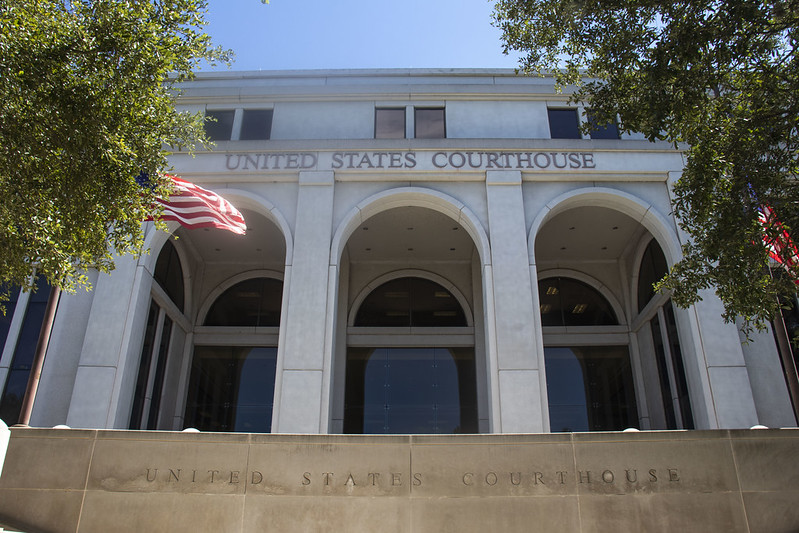Gov. Ron DeSantis’ motivation for signing a congressional map that eliminated North Florida’s only district where African American voters could elect their candidate of choice was at the center of a federal trial that ended this week.
“If the decision of the judges is going to be based on the evidence presented in this case that all fell in line — it was sort of a sequential building of evidence throughout the days — I think we should win,” said Dot Inman-Johnson, former Tallahassee mayor and city commissioner, who’s also one of the plaintiffs suing over the map.
On Tuesday, U.S. District Judges M. Casey Rodgers and Allen Winsor and U.S. Circuit Judge Adalberto Jordan heard closing arguments from attorneys after about three to four days of witness testimony. The federal three-judge panel is set to issue a decision on the constitutionality of North Florida’s congressional districts by early next year to give lawmakers time to adopt a new map during the 60-day regular lawmaking session if the current one is struck down.
Plaintiffs suing over the state’s map include civil rights groups Common Cause and the NAACP, along with several voters. They argue DeSantis and the Legislature enacted congressional districts in North Florida that were intentionally racially discriminatory.
During closing arguments, plaintiffs’ attorneys focused largely on DeSantis’ statements and actions regarding the region’s congressional districts, including his veto of two of the Legislature’s proposed maps.
Attorneys for the state argue that it was impossible to draw a Black-performing district in the region that complied with the state and federal constitutions.

Plaintiffs attorneys focus on governor’s veto of a Black-performing district in Duval County
After the governor threatened to veto a map that preserved the former District 5, lawmakers passed a plan that would’ve created a Black-performing district solely located in Duval County. But DeSantis also rejected that configuration.
“In poker, this is the tell,” said Gregory Diskant, an attorney for the plaintiffs, during closing arguments. “The tell that he’s at least in part motivated by racial animus.”

Diskant reminded the judges that the primary reason DeSantis gave for opposing the previous District 5 was that it was too long — stretching about 200 miles from Gadsden County to eastern Duval County. Still, the governor vetoed the Legislature’s attempt to solve that problem by placing a more compact district solely in Duval County.
“Why in the world didn’t he say ‘thank you?’” Diskant said. “Thank you for taking his objections seriously.”
Desantis vetoed the plan and called lawmakers into a special session to pass a map drafted by his office. Without considering another plan, the Republican-controlled Legislature swiftly passed the governor’s map, which didn’t contain a single Black-performing district in the region. Plaintiffs’ attorneys argue that no individual legislator acted with racially discriminatory intent, yet the Legislature is still responsible for approving the governor’s map. “They don’t get a free pass,” Diskant said.
The Duval-only District 5 map that the Legislature originally approved resembled state Senate District 5, and the surrounding District 4 is shaped like Senate District 4, plaintiffs’ attorneys explained to the judge. They said the fact that DeSantis never spoke out publicly against the state Senate map is another inconsistency in his arguments against the Legislature’s map.
U.S. Circuit Judge Adalberto Jordan said that was one of his concerns. “There’s a complaint on one, but no complaint or challenge on the other.”

Another concern Jordan said he has with the governor’s map is the fact that the governor rejected the proposed Duval-only District 5 partly on the basis that the Black voting age population went down from the previous District 5, yet the governor’s map wiped a Black-performing district from the region altogether. “That’s a problem for me,” Jordan said.
The previous District 5’s Black voting age population was 46%, while 35% of the voters in the Legislature’s proposed Duval-only District 5 were African American. That would’ve resulted in a district that performed for Black voters two-thirds of the time, based on evidence presented during the trial.
DeSantis’ attorney Ryan Newman argued in a memo accompanying the governor’s veto that the reduction of Black voters in the district was more than “slight” and violated the state Constitution’s prohibition on diminishing a minority group’s ability to elect their candidate of choice.
“Here’s a problem. I want to avoid this problem. In order to avoid this problem, I’m going to make it worse?” Jordan said to attorneys representing the state. “I just can’t get my head around it.”
Jordan said he was also concerned about the fact that the governor rejected the length of the previous District 5, yet he approved a 200-mile-long district that connects Panama City and Tallahassee.
Lead attorney for the state Mohammad Jazil told Jordan that it was necessary for the governor’s office to draw District 2 nearly 200 miles long because it covers a largely rural area and each district in the state must contain the same number of people. Conversely, he argued there was no reason to draw a 200-mile district from Gadsden County to eastern Duval other than wanting to preserve an African American opportunity district.
9(MDEwNzczMDA2MDEzNTg3ODA1MTAzZjYxNg004))







